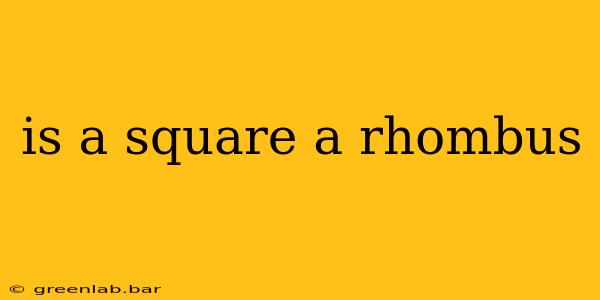The question of whether a square is a rhombus often arises in geometry discussions. The answer is yes, a square is indeed a special type of rhombus. To understand why, let's delve into the defining characteristics of both shapes.
Defining a Rhombus
A rhombus is a quadrilateral (a four-sided polygon) with all four sides having equal length. Think of it as a "pushed-over" square; it's a parallelogram where all sides are congruent. However, its angles aren't necessarily right angles.
Key Rhombus Properties:
- Four equal sides: This is the defining characteristic.
- Opposite sides are parallel: A consequence of the equal side lengths.
- Opposite angles are equal: Another result of its parallel sides.
- Consecutive angles are supplementary: Meaning they add up to 180 degrees.
Defining a Square
A square, on the other hand, is a more specialized quadrilateral. It possesses all the properties of a rhombus and more.
Key Square Properties:
- Four equal sides: Just like a rhombus.
- Four right angles (90-degree angles): This is the crucial difference.
- Opposite sides are parallel: Inherited from its rhombus properties.
- Opposite angles are equal: Also inherited from rhombus properties.
- Diagonals are equal and bisect each other at right angles: This is an additional property squares possess.
The Relationship: Square as a Special Case of Rhombus
Since a square fulfills all the requirements of a rhombus (four equal sides), it's classified as a special case of a rhombus. Think of it this way: all squares are rhombuses, but not all rhombuses are squares. The additional constraint of having right angles elevates a rhombus to the status of a square.
Other Related Quadrilaterals
Understanding the relationship between squares and rhombuses helps clarify the broader classification of quadrilaterals. Other related shapes include:
- Rectangle: A quadrilateral with four right angles (but not necessarily equal sides).
- Parallelogram: A quadrilateral with opposite sides parallel. Rhombuses and rectangles are special types of parallelograms.
Conclusion
In summary, a square is a rhombus because it satisfies the definition of a rhombus: four equal sides. The square adds the extra condition of having four right angles, making it a more specific and restricted type of rhombus. This understanding is crucial for grasping geometrical relationships and solving various geometrical problems.

